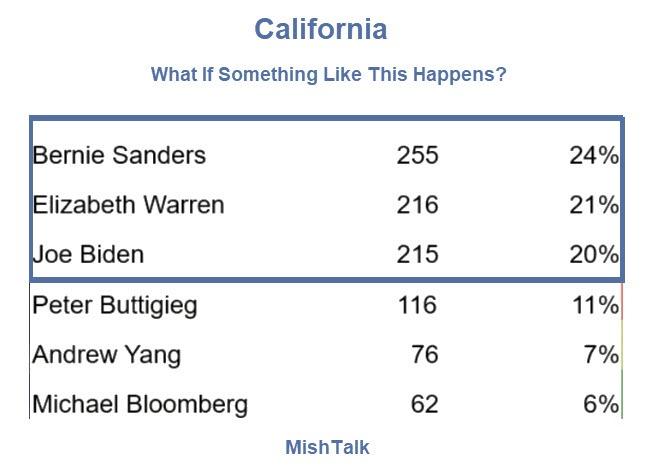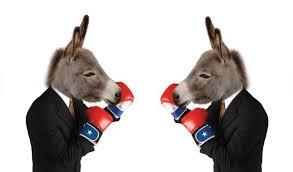What Are The Odds Of No Winner In The Democratic Primaries?
Authored by Mike Shedlock via MishTalk,
Let’s investigate the possibility no Democratic candidate will amass 50% of the votes resulting in a brokered convention…
It’s not posted yet anywhere I can find, but I am told those are the results of the latest California poll taken in January.
Regardless, let’s assume something like that represents the current state of affairs.
How would that impact the the Democratic primary process?
Proportional Voting
Republicans have winner-take-all rules but the Democrats generally have some sort of proportional allocation typically with a 15% threshold.
In California, 35% of the votes are statewide, the rest by district.
15% Threshold
The above chart is from Nate Silver 538: 15 Percent Is Not A Magic Number For Primary Delegates.
Democrats allocate their delegates proportionately among candidates who get 15 percent or more of the vote in a given state or district. So, for instance, if Bernie Sanders gets 42 percent of the vote in a certain state, Kamala Harris gets 18 percent, Joe Biden gets 14 percent, Pete Buttigieg gets 11 percent, Cory Booker gets 10 percent and Marianne Williamson gets 5 percent, then only Sanders and Harris would get state-level delegates, with Sanders getting 70 percent of the delegates and Harris getting the other 30 percent.
The part that’s easy to miss is in that term state-level delegates. In the Democratic primaries, only about 35 percent of delegates are actually allocated at the state level. The remaining 65 percent are allocated by district — usually by congressional district, although some states use different methods such as by county (Montana and Delaware) or state legislative districts (Texas and New Jersey).
The following discussion explains the weird looking chart and the big jump that happens precisely at 15%.
California Rules
According to the California Democratic Party 2020 Delegate Selection Overview, the California Delegation will send a total of 495 delegates the Democratic National Convention comprised of 416 Pledged Delegates and 79 Unpledged Delegates.
Of the pledged delegates, 90 are at-large (statewide) delegates. Another 54 are pledged party leaders (mayors, legislators, state officials, etc.) committed to candidates who get at least 15% of the vote.
(90+54)/416 = 35%
Of the pledged delegates, 326 are allocated by district. The 15% rule comes into play, but at the district level.
Let’s run the above math based on the latest California poll.
California Statewide Math
-
24 + 21 + 20 = 65
-
Sanders would get 24/65ths of the statewide delegates (37%)
-
Warren would get 21/65ths of the statewide delegates (32%)
-
Biden would get 20/65ths of the statewide delegates (31%)
-
Sanders would get 33 statewide delegates.
-
Warren would get 29 statewide delegates.
-
Biden would get 28 statewide delegates.
Those are the statewide allocations.
Pledged Delegate District Math
Sanders would get 24% minimum of 326 district delegates.
Warren would get 21% minimum of 326 district delegates.
Biden would get 20% minimum of 326 district delegates.
Those are approximations for two reasons.
Although there is a 15% minimum, that also applies at the district level. It’s possible that Sanders, Warren, or Biden would not get 15% in every district.
It is also possible some candidates get 15% in some districts without hitting the 15% statewide threshold.
Consider the possibility Buttigieg got 15% in half the districts but only 11% statewide. In that case he would get about 7.5% of the 326 or 24 delegates.
Projections
Project something similar three-way splits across Texas, Illinois, Florida, and New York. Guess what? You have no overall winner and thus a “Brokered Convention“.
The Democratic Party’s 1968 convention might have been brokered if Robert F. Kennedy had not been assassinated. He had won four of the primaries including California, but not enough delegates were then selected by primaries to determine the presidential nominee. President Lyndon B. Johnson, who had decided against running for a second full term, still controlled most of the party machinery and used it in support of Vice President Hubert Humphrey, who did not contest the primaries, although two surrogates won their home states. If Kennedy had lived, the convention likely would have been divided between his and Humphrey’s supporters.
The last brokered conventions were Adlai Stevenson (of the 1952 Democratic Party) and Dwight Eisenhower (of the 1952 Republican Party).
A friend of mine says there will never be another Democratic brokered convention.
I think the odds may be as high as 20% this year. Nate Silver has them as a 15% chance right now.
What Would It Take?
Nearly any three-way or four-way split that lasts long enough.
If Sanders, Biden, and Warren hold a 20% threshold through the California primary, that would likely do it.
Even 15% might be enough.
And it would not even take the same three.
For example, Buttigieg might get 15% in Iowa, Illinois, and Indiana. Perhaps Bloomberg gets 15% in New York and Texas. Give Warren 15-20% in California, Illinois, Iowa, etc.
There you have it, a brokered convention.
Tyler Durden
Sun, 01/12/2020 – 15:10
via ZeroHedge News https://ift.tt/3a1hpS8 Tyler Durden


